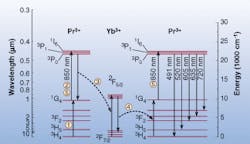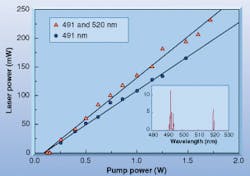Upconversion fiber lasers are becoming their own family of visible-output lasers. They benefit from the intrinsic frequency conversion. The active medium is an optical fiber, with the large surface providing efficient cooling. Excellent transversal mode quality follows from the optical properties of the fiber. With narrow-bandwidth emissions in the red, green, and blue available, applications range from display technology to medical and biological uses, enabling fiber lasers to replace lower-power bulky ion or metal-vapor lasers. Therefore, research efforts aim to enhance the emission at different spectral lines and to improve the overall efficiency by applying diode-laser pumping.
At the Friedrich-Schiller University of Jena (Jena, Germany), Andreas Tünnermann and his coworkers Holger Zellmer and Peter Riedel continue the work they started a few years ago at the Laser Zentrum Hannover (Hannover, Germany). There, they demonstrated laser emission in the red (635 nm) and green (520 nm) out of praseodymium/ytterbium (Pr/Yb) doped double-clad ZBLAN (zirconium barium lanthanum aluminum sodium fluoride) fibers pumped by a Ti:sapphire laser at 840 nm (see Laser Focus World, May 1998, p. 15). However, output in the blue was still fairly weak and unstable.
The team has recently reported 150-mW output at 491 nm (blue-green) for several hours without degradation in a single-clad fiber with Ti:sapphire laser pumping and expects further power scaling by again applying the double-clad fiber concept.1 The breakthrough in the blue came from a redesign of the laser cavity and a strong spectral selection in favor of the 491-nm line.
Upconversion process
Lasing by upconversion means applying two infrared (IR) photons to a medium that responds by emitting one photon in the visible. Physically, a highly excited energy level is populated by stepwise excitation through an intermediate level. Lasing can occur on transitions to levels distributed from the intermediate level to the ground state. If the intermediate level is situated at half the energy of the highly excited one, only one pump source is required.
The praseodymium ion (Pr3+) displays a nearly ideal energy-level scheme, allowing it to reach the highly excited level by two photons around 850 nm via the intermediate 1G4 level (see Fig. 1, p. 42). However, the highest cross section for the transition from ground state to 1G4 is around 1035 nm. When pumped at 850 nm, this excitation occurs only by a "wing" transition, hence this is not very efficient (step 1). For the second transition from 1G4 to 3P0,1 (step 2), the optimum wavelength is in the 840–860-nm range. This mismatch in excitation wavelengths can be solved using two different approaches: by use of a second pump wavelength at 1035 nm or by use of a suitable codopant to transform 850-nm pump photons into 1035-nm photons.
For this purpose Yb3+ is used. Its 2F5/2 level is populated efficiently in a nonradiating process (step 3), inducing resonance energy transfer (step 4) to another Pr3+ ion so that, after absorbing a total of four IR photons, two Pr3+ ions are in the highly excited state ready for lasing. This pumping scheme is called an avalanche process because, when the first photon is absorbed with low efficiency, three more photons are absorbed with higher efficiency. As the net result of pumping and radiationless decay to the lowest sublevel, the highly excited 3P0 of Pr3+ is ready to emit in competing transitions into levels of the ground multiplet, to be used as lasing transitions.
The Jena team chose Le Verre Fluoré (Bruz, France) ZBLAN fiber doped with 3000-ppm Pr3+ and 20,000-ppm Yb3+ ions, with a core diameter of 3.5 µm, a clad diameter of 125 µm, and a length of 30 cm. The numerical aperture of the core was 0.16. The laser mirrors were either glued or directly coated on the fiber endfaces. Experiments were performed using a tunable Ti:sapphire laser and a diode laser as the pump source. Spectroscopic investigations and power measurements were performed with the Ti:sapphire laser. In this way, applying 500 mW as the pump power, lasing could be induced by varying the wavelength of the pump laser in the 780- to 880-nm range, with a maximum output obtainable when pumped between 845 and 860 nm. The lifetime of the upper laser level was measured (22 µs), cross sections for stimulated emission were determined, and studies of the noise spectrum were performed.
Blue operation
Using the Ti:sapphire laser at 840 nm and laser mirrors for the 491-nm line designed to suppress all other laser lines, an output of 165 mW was achieved when pumped with 1.6 W; the output power remained stable over several hours (see Fig. 2). The slope efficiency was 12%, and the threshold pump power was 140 mW. Increasing the pump power to greater than 1.6 W made the 520-nm line appear. Consequently, with broadband laser mirrors for blue and green laser operation, powers up to 230 mW were reached, with 75% of the power in the 491-nm line. The slopes of both curves indicate that further power scaling is possible using techniques such as double-clad fibers.Researchers were able to couple 140 mW into the fiber (70% of 200 W) using a laser diode from SDL (San Jose, CA) at 840 nm, equipped with a commercial fiber coupler consisting of two aspherical lenses and a cylinder telescope (Schäfter & Kirchhoff; Hamburg, Germany). With a 7% outcouple mirror, laser output in the blue of 8 mW was achieved. Recently, the output was increased to 14 mW by improving the outcoupling rate. Long-term investigations are in progress.
REFERENCE
- H. Zellmer, P. Riedel, and A. Tünnermann, App. Phys. B69(5/6), 417 (1999).
About the Author
Uwe Brinkmann
Contributing Editor, Germany
Uwe Brinkmann was Contributing Editor, Germany, for Laser Focus World.

